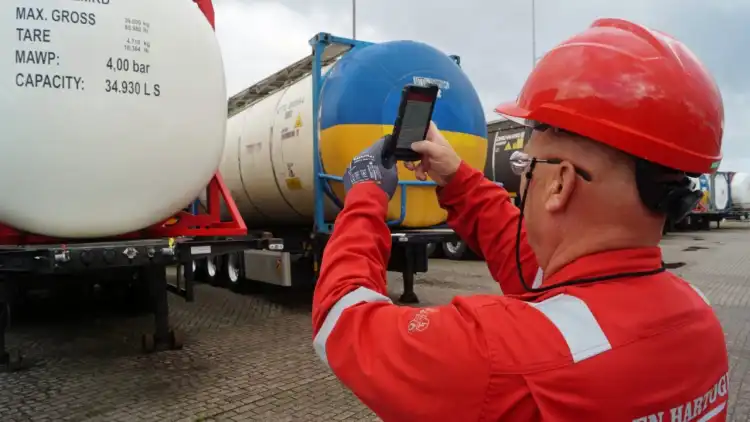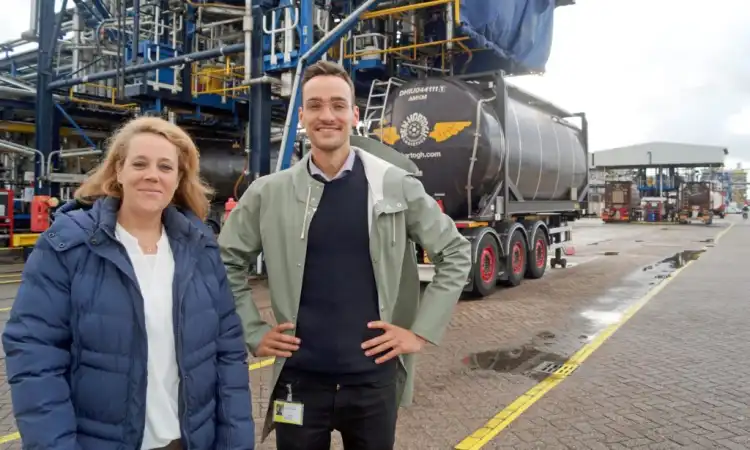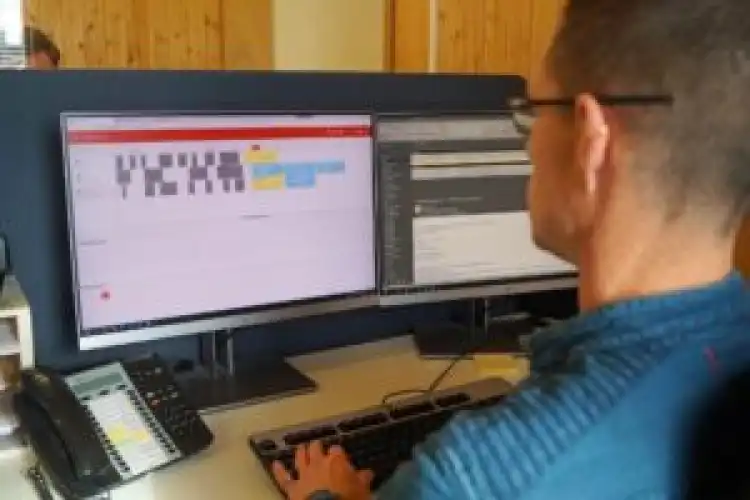For two years Huntsman and Den Hartogh Logistics have been working on a tool to get the right truck to the right location on the site. The custom-built system called ShuntPlan is now up and running, and the results have exceeded expectations. A lot of manual work has been replaced, and the level of control over the number of errors has reached a high level. Online platform Logistiek.nl recently published an article about ShuntPlan:
What do you do if your standard yard management system falls short? The answer that Huntsman and Den Hartogh Logistics came up with together was that you build an application of our own. The new tool allows the chemicals manufacturer and the logistics service provider to control all logistical operations at and around the plant at Rotterdam Botlek.
‘The result gives us greater insight, prevents errors and ensures a better workflow. We call it ShuntPlan,’ says Rosina Kleijburg-Hanssen, Supply Chain Process and Logistics Project Manager at Huntsman Polyurethanes Rotterdam. The company makes semi-finished products for the polyurethane industry, i.e. a raw material for end products such as mattresses, chairs, shoe soles and PUR foam.

Tom Pijl, IT Manager for Connected Sites & Workforce at Den Hartogh: ‘In the end, we showed which tools could improve insight into business operations and help prevent errors. With these kinds of products, the ‘first time right’ principle is rather important.’
Visibility tool for customers
The Huntsman management’s desire for more insight into processes accelerated the development of the current tool. Pijl: ‘With this in mind and knowing that more customers shared this need, choosing to invest in an IT tool for on-site logistics made perfect sense to us.’ In early 2019, development began on what would eventually see the light of day as ‘ShuntPlan’.

Rosina Kleijburg-Hanssen (Huntsman) en Tom Pijl (Den Hartogh Logistics)
This system is able to track a large number of activities at Huntsman’s Rotterdam Botlek site. It covers truck arrivals, weighing, inspection, documentation, shunting, planning, warming up, loading, unloading and site logistics. Until the roll-out of ShuntPlan, these operations were performed by hand, in the form of phone calls, paper documents and the use of Excel spreadsheets. Kleijburg-Hanssen: ‘Although you can get quite good at it, there is also an increased likelihood of errors. That is what we wanted to prevent happening.’
First all tick boxes on green
From the moment a vehicle arrives at the production site, ShuntPlan and the employees involved begin a series of checks. Firstly, the tank is scanned, and then it undergoes a Technical Tank check. The check is performed by answering a questionnaire via the mobile application. After this technical tank inspection ShuntPlan will perform several automated checks. From scanning a tank container by the load operator to checking whether the amount of liquid fits in the appropriate tank and checking whether the tank is in the right location.
Pijl: ‘We even include the moments the reactor is connected and disconnected.’ Before rolling out the software, the manufacturer and the logistics service provider used a paper loading order, several spreadsheets and other means of communication. Now they use a handheld device and a question path. Pijl: ‘If the data is incorrect, we cannot start loading. All the ticks have to be green, otherwise ShuntPlan will block any next step.’
Checks at each step
The supply chain team draws up the production schedule and makes sure the raw materials arrive in time for the unloading appointment and that the containers are in place and ready for loading. The Huntsman Process Operator then takes charge of the production process. To reach a point at which there are only green ticks, ensuring error-free placement, each function is covered by a built-in system of checks. Each step in the loading/unloading process had been digitised.
‘Each step in the loading/unloading process had been digitised’
The system receives the order and corresponding tank information from SAP software and links it to the tank information from the Den Hartogh Transport Management System (TMS). The Huntsman Process Operator then requests tank equipment using ShuntPlan and tracks its status like following a package bought online. The on-site planner receives a chain or planning cards in his dispatch overview and drags it to one of the trucks. The truck/driver receives a job assignment complete with all relevant information such as where to pick up which tank. The Den Hartogh Load Operator then performs scans and checks for the loading locations. ShuntPlan will check whether a tank has actually been requested (driver could have taken wrong tank) and whether the product and the order will fit into the available tank. The Load Operator then takes a picture of the connection. This is followed by a number of steps, each requiring confirmation.
The Den Hartogh drivers use on-board computers and handheld devices to perform tasks such as taking temperature readings. Inspection workers carry out the technical tank inspections and also use handheld devices for taking pictures and completing questionnaires. Counter staff, account managers and planners also use the application. The planning department uses it to see if a tank has been loaded and can leave.
More variables than usual
Den Hartogh believes the number of variables that the application processes in the scheduling and handling of activities is more than a standard yard management system can handle. Pijl explains that a standard yard management tool would be enough to handle the basic flow of operations. ‘But when production flows get more complex, we need more. Take, for example, the operations needed if we have to make a correction. Huntsman makes the product, but we still have to wait for a quality assessment from the lab. Then we can wait for the ‘OK’ message to appear in ShuntPlan. However, sometimes corrective action is required. Not only can we see all waiting products visible in the schedule; Huntsman can also put in a request for a container and indicate how by many kilograms it needs to be corrected. Another fill-level check is then carried out. It can then be rechecked after loading. After all, new orders are not always exactly the same.’
‘It provides us with a uniform way of working and KPIs so we can measure our progress’
Behind the scenes, the new application is linked to the SAP ERP system and the Transfusion TMS. Kleijburg-Hanssen: ‘It gives us greater operational insight, reduces the chance of errors, provides us with a uniform way of working and KPIs so we can measure our progress – for example, in terms of how long a certain action takes. We can also track actions and see which operations are running smoothly and where improvements could be made. Whereas previously an operator would always need to rely on paperwork, now the tool uses green ticks to verify actions, such as whether a container has been ordered for loading or unloading.'

Smoothly running ‘happy flow’
The most significant improvement that Huntsman and Den Hartogh have achieved is a smoothly running ‘happy flow’. Pijl explains that this creates calm and a sense of control. ‘And when someone clicks the request button, we know that the container is there and the operator no longer needs to call. Previously, our drivers were our ears and eyes on site, but they had only a limited view of the schedule and could not make decisions. Now everyone can see right away if a truck has been loaded and whether there is an opportunity to load another one.’
The new way of working is a huge change for both organisations. ‘It’s going well though. We laid the foundations by asking for a lot of feedback from all involved at the beginning of the roll-out,’ says the Project Manager. Pijl adds: ‘We decided to explain the system to all employees who would be working with the application three at a time. Firstly, we explained the concept of ‘happy flow’ and then the exceptions.
Developed in-house
Step by step, the supply chain team, the planners and others are gaining more insight into where things are running smoothly and where some tweaking is still required. Part of the production sets off in bulk for an end customer, another Huntsman location or is placed in storage. Kleijburg-Hanssen: ‘Previously, planners and the supply chain team used to coordinate operations together. However, our planners lacked insight into where exactly the containers were located. Now they can see for themselves whether the filling schedule needs to be altered. Having greater insight means the planner can inform the haulier sooner about the best loading time when something changes on the site.’
Now that the basis of ShuntPlan has been rolled out, both the manufacturer and Den Hartogh Logistics are looking at how the product can be used more broadly. The fact that this is happening at the same time as there is greater supply chain uncertainty due to the coronavirus is a coincidence. ‘Corona illustrates the need for this because it has increased pressure on the supply chain.’
The application was developed in-house, in the sense that the developer Inforit is partly owned by the logistics service provider. Pijl: ‘First we will look at what more we can add to this basic application. For instance, whether to include shuttle material, the scanning of QR codes on the loading piers and a number of other steps. Then we will see whether we can also offer the tool to other Den Hartogh customers. There is currently a lot of demand for improving insight at production sites. So, I can definitely see opportunities for this product.’
Source: Logistiek.nl
Logistiek.nl is the largest website for logistics professionals in the Netherlands.